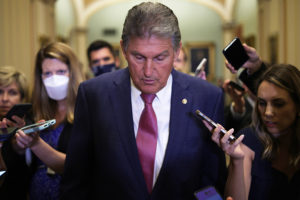Swamponomics: Government Workers, Waiters Lead July Job Gains

The dog days of data are here, and the United States economy can take a cold shower and sip on a can of Sprite. Despite doom and gloom prognostications of the Delta and Lambda variants, the U.S. labor market is moving on from the coronavirus pandemic – or trying to, at the very least. So, with the jobs report coming in better than what most economists had anticipated, should Bidenomics take a bow? Perhaps the answer is quality over quantity.
Bartenders and Civil Servants
According to the Bureau of Labor Statistics (BLS), the U.S. economy created 943,000 new jobs in July, up from 938,000 positions in June. The market had penciled in a gain of 870,000. The unemployment rate fell sharply to 5.4%, down from 5.9% in June. The median estimate was a jobless rate of 5.7%.
Nearly every sector recorded growth to kick off the third quarter. Only the retail and utility sectors posted losses, with 5,500 and 100 lost jobs, respectively. Here were the job creators:
- Leisure and hospitality: 380,000
- Government: 240,000
- Professional and business services: 60,000
- Transportation and warehousing: 49,700
- Health care and social assistance: 46,800
- Manufacturing: 27,000
- Construction: 11,000
But not everyone was bullish on the report, citing the two drivers of the job gains: restaurant workers and civil servants. Carl Riccadonna, a Bloomberg Intelligence economist, explained in a research note:
“The jobs report is sturdy, but not as strong as it looks. In addition to the modest fade in the pace of private-sector hiring (703,000 in July vs. 769,000 in June), much of the July gain occurred in the tenuous leisure and hospitality sector — and that could easily reverse due to Covid-19. This already appears to be evident in metrics such as OpenTable bookings. So if we look at private-sector hiring outside of leisure and hospitality, today’s reported gain was 323,000, a bit slower than the prior month’s 375,000. This tells us that underlying economic momentum is steady-state, not accelerating.”
Moreover, the BLS confirmed that average hourly earnings rose 0.4% in July to $30,54. Average weekly hours were flat at 34.8, while the labor force participation rate edged up to 61.7%. Even without this robust data, one key metric suggested that the labor market has normalized and stabilized. There are now more employment openings (9.2 million) than out-of-work Americans (8.7 million).
Is It Time to Taper QE-Infinity?
Following the stellar jobs numbers, gold and silver melted like an ice cube on a sidewalk in the middle of summer. Why does this matter? It signaled that the gold bugs and silver stallions believe this gives the Federal Reserve ammunition to begin tapering its QE-infinity campaign, something that would ease soaring inflation. While Fed Chair Jerome Powell has noted that the central bank would be maintaining loose monetary policy until the pandemic is far in the rear-view mirror, James Bullard, the president and CEO of the Federal Reserve Bank of St. Louis, recently stated that it is time for the Eccles Building to commence a plan to unwind the enormous $120-billion-a-month program.
Dallas Fed Bank President Robert Kaplan echoed a similar sentiment, recommending the institution cut monthly Treasury purchases by $10 billion and mortgage-backed security acquisitions by $5 billion. But can the national economy and broader financial markets survive without this support?
Manchin on Austrian Theory Over Inflation
Senator Joe Manchin (D-WV) penned a letter to the U.S. central bank, expressing how “alarmed” he is by Powell and the Federal Open Market Committee (FOMC) slapping an inflation tax on the nation’s middle class and potentially overheating the economy. Sen. Manchin wrote:
“The Fed has sustained $120 billion per month in asset purchases since June 2020, despite increasing vaccination rates to combat the virus and additional fiscal stimulus from Congress in the ARP. The record amount of stimulus in the economy has led to the most inflation momentum in 30 years, and our economy has not even fully reopened yet. I am deeply concerned that the continuing stimulus put forth by the Fed, and proposal for additional fiscal stimulus, will lead to our economy overheating and to unavoidable inflation taxes that hard working Americans cannot afford.”
Is the senator a subscriber to the Austrian School of Economics now? This also shows the growing divide within the Democratic Party since he has homed in on monetary policy as a source of inflation. Like Rep. Alexandria Ocasio-Cortez (D-NY), others have attributed the inflation bomb to the shipping container crisis. Who is right? Most importantly, can cash-strapped consumers afford to wait a long time to find out?
Debt Crazy
When interest rates are as low today, why would you not go on a spending spree, borrowing more than you can afford to make up for lost time? According to the latest Fed data, consumer credit swelled by $37.69 billion in June, representing the fourth consecutive monthly increase. U.S. household debt jumped by $313 billion in the second quarter, or 2.1%, fueled by a dramatic boost in credit card spending and mortgage debt. Overall, U.S. consumers are $14.96 trillion in the red.
What happens when the Fed raises rates even by a minuscule 25 basis points? It will cost many households a considerable portion of their paychecks to keep up with their debt-servicing payments.
The post Swamponomics: Government Workers, Waiters Lead July Job Gains was first published by Liberty Nation, and is republished here with permission. Please support their efforts.





